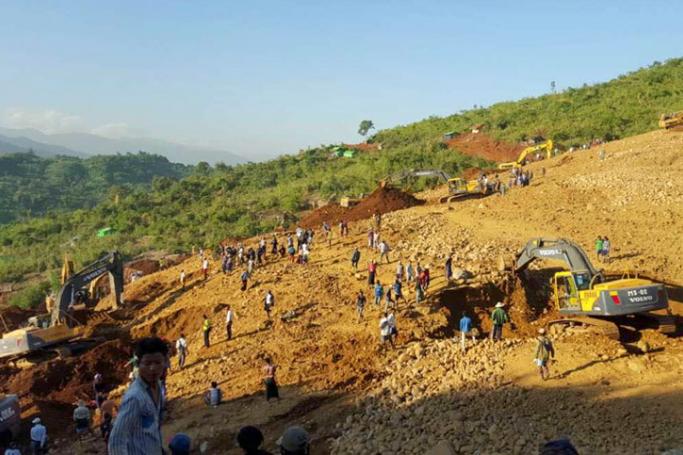At least 104 people have died in a huge landslide in a remote jade mining area of northern Myanmar, officials said Sunday, as search teams continued to find bodies in one of the deadliest disasters to strike the country's shadowy jade industry.
Those killed were thought to have been scavenging through a mountain of waste rubble dumped by mechanical diggers used by mining firms in the area to extract Myanmar's most valuable precious stone.
The massive landslide crushed dozens of flimsy shanty huts clustered on the barren landscape, where an unknown number of itinerant workers had made their homes in the hope of finding riches on the side of the secretive multi-billion dollar jade industry in war-torn Kachin state.
"We found 79 dead bodies on November 21 (and) 11 today so the total so far is 90," said Nilar Myint an official from the local administrative authorities in Hpakant, northern Kachin, adding that the rescue operation was ongoing.
"We are seeing only dead bodies and no one knows how many people live there," he told AFP, adding that only one person had been pulled alive from the rubble, but had died soon after.
Myanmar is the source of virtually all of the world's finest jadeite, an almost translucent green stone that is prized above almost all other materials in neighbouring China.
Landslides are a common hazard in the area as people living off the industry's waste pick their way across perilous mounds under cover of darkness, driven by the hope that they might find a chunk of jade worth thousands of dollars.
Scores have been killed this year alone as local people say the mining firms, many of which are linked to the country's junta-era military elite, scale up their operations in Kachin.
- 'Dystopian wasteland' –
Nilar Myint said rescuers workers from the Myanmar Red Cross, the army, police and local community groups were all at the scene trying to dig people out of the earth, but their efforts have been hampered by poor weather conditions overnight in the remote region.
In an October report, advocacy group Global Witness estimated that the value of jade produced in 2014 alone was $31 billion, the equivalent of nearly half the country's GDP.
But that figure is around 10 times the official $3.4 billion sales of the precious stone last year, in an industry that has long been shrouded in secrecy with much of the best jade thought to be smuggled directly to China.
Local people in Hpakant complain of a litany of abuses associated with the mining industry, including the frequency of accidents and land confiscations.
The area has been turned into a moonscape of environmental destruction as huge diggers gouge the earth looking for jade.
Itinerant miners are drawn from all parts of Myanmar by the promise of riches and become easy prey for drug addiction in Hpakant, where heroin and methamphetamine are cheaply available on the streets.
"Industrial-scale mining by big companies controlled by military families and companies, cronies and drug lords has made Hpakant a dystopian wasteland where locals are literally having the ground cut from under their feet," said Mike Davis of Global Witness, calling for firms to be held accountable for accidents.
The group wants the jade industry, which has long been the subject of United States sanctions, to be part of the Extractive Industries Transparency Initiative (EITI), a global scheme designed to increase transparency around natural resource management.
©AFP
Story updated to reflect latest official figure
You are viewing the old site.
Please update your bookmark to https://eng.mizzima.com.
Mizzima Weekly Magazine Issue...
14 December 2023
Spring Revolution Daily News f...
13 December 2023
New UK Burma sanctions welcome...
13 December 2023
Spring Revolution Daily News f...
12 December 2023
Spring Revolution Daily News f...
11 December 2023
Spring Revolution Daily News f...
08 December 2023
Spring Revolution Daily News f...
07 December 2023
Diaspora journalists increasin...
07 December 2023
China slams UN Xinjiang report as 'political tool'












